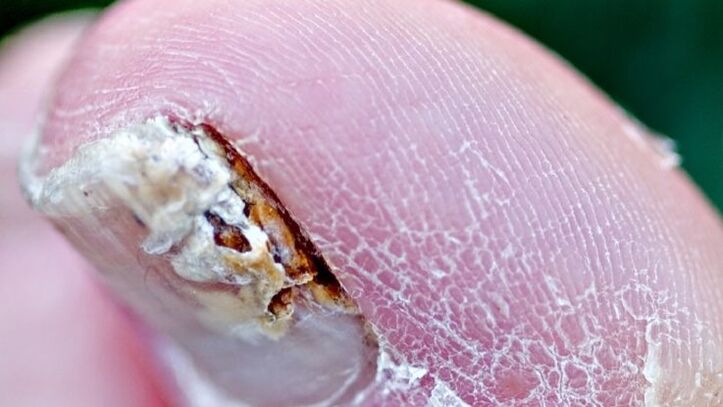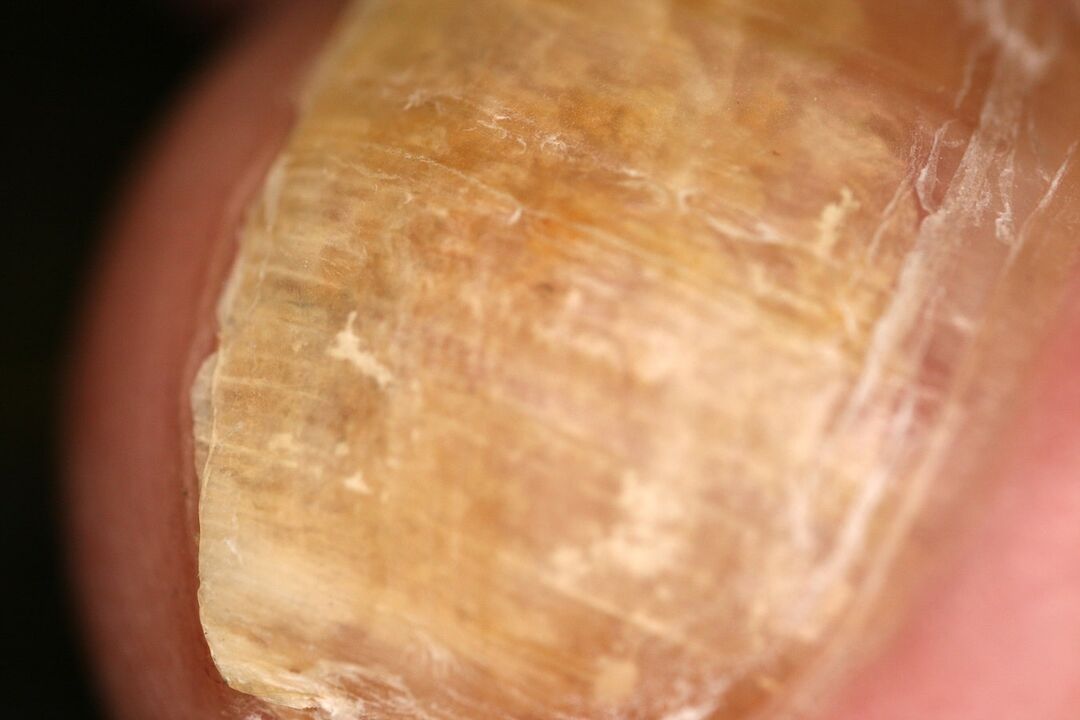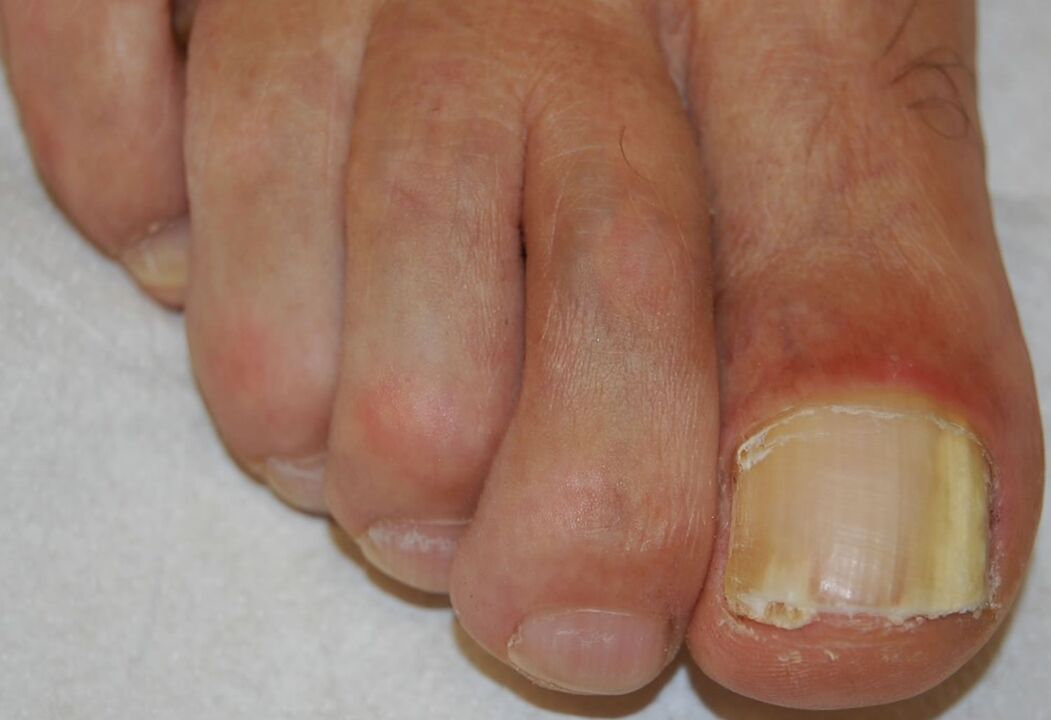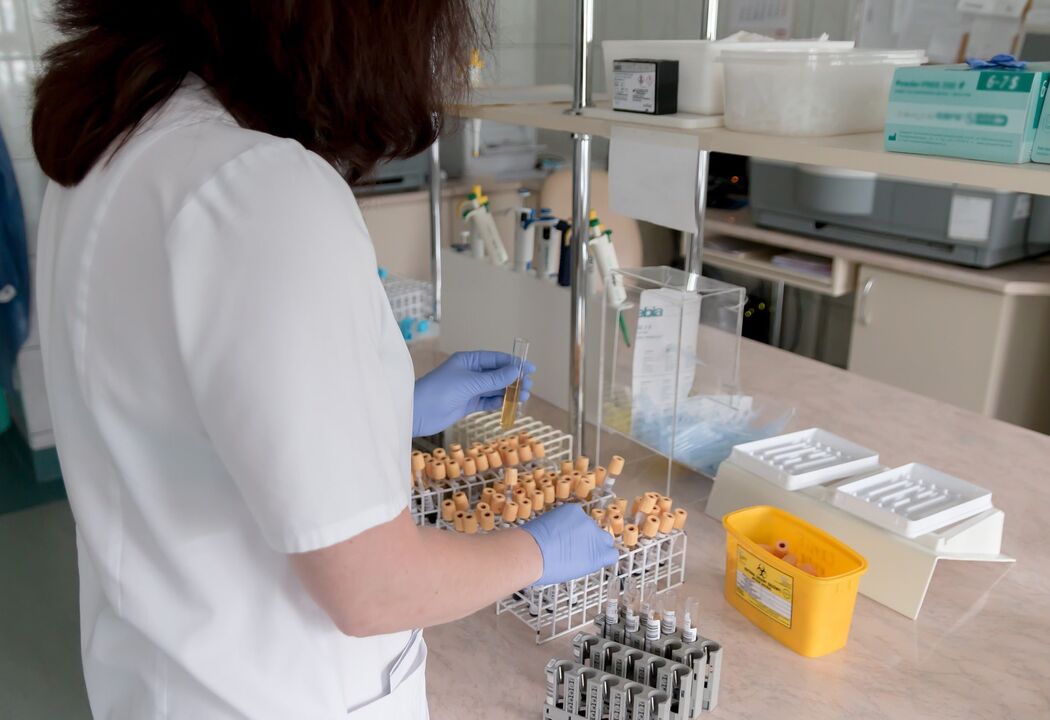The term onychomycosis (toenail fungus) describes a fungal nail infection caused by dermatophytes, non-dermatophyte molds, or yeasts. There are four clinically distinct forms of onychomycosis. Diagnosis is based on KOH examination, microscopy and histology. Most often, treatment includes systemic and local therapy, sometimes surgical removal is resorted to.

Factors contributing to the appearance of nail fungus
- Increased sweating (hyperhidrosis).
- Vascular insufficiency. Violation of the structure and tone of the veins, especially the veins of the lower extremities (characteristic of toenail onychomycosis).
- Age. The incidence of the disease in humans increases with age. In 15-20% of the population, the pathology manifests itself at the age of 40-60.
- Diseases of internal organs. Disturbance of the nervous, endocrine (most often onychomycosis occurs in people with diabetes) or immune (immunosuppression, especially HIV infection) systems.
- A large nail mass, which consists of a thick nail plate and the contents below it, can cause discomfort when wearing shoes.
- Traumatizing. Permanent nail trauma or injury and lack of proper treatment.
Disease spread
Onychomycosis– the most common nail disease, which is the cause of 50% of all cases of onychodystrophy (destruction of the nail plate). It affects up to 14% of the population, with the prevalence of the disease in older people and the overall incidence increasing. The incidence of onychomycosis in children and adolescents is also increasing; onychomycosis accounts for 20% of dermatophyte infections in children.
The increase in the prevalence of the disease may be related to the wearing of tight shoes, the increase in the number of people taking immunosuppressive therapy and the increasing use of public changing rooms.
Nail disease usually begins with tinea pedis before spreading to the nail bed, where eradication is difficult. This area serves as a reservoir for local recurrence or spread of infection to other areas. Up to 40% of patients with onychomycosis of the toes have combined skin infections, most commonly tinea pedis (about 30%).
The causative agent of onychomycosis
In most cases, onychomycosis is caused by dermatophytes, with T. rubrum and T. interdigitale being the causative agents of the infection in 90% of all cases. T. tonsurans and E. floccosum have also been documented as etiological agents.
Yeasts and non-dermatophyte molds such as Acremonium, Aspergillus, Fusarium, Scopulariopsis brevicaulis and Scytalidium are the source of onychomycosis of the toes in approximately 10% of cases. It is interesting to note that Candida species are causative in 30% of cases of onychomycosis of the fingers, while non-dermatophyte molds are not found in affected nails.
Pathogenesis
Dermatophytes have a wide range of enzymes that, acting as virulence factors, ensure the adhesion of the pathogen to the nails. The first stage of infection is adhesion to keratin. Due to the further degradation of keratin and the cascade release of mediators, an inflammatory reaction develops.

The stages of the pathogenesis of fungal infection are as follows.
Adhesion
Fungi overcome several lines of host defense before hyphae begin to survive in keratinized tissues. The first is the successful adherence of arthroconidia to the surface of keratinized tissues. Early nonspecific lines of host defense include sebum fatty acids as well as competitive bacterial colonization.
Several recent studies have investigated the molecular mechanisms involved in the adhesion of arthroconidia to keratinized surfaces. Dermatophytes have been shown to selectively use their proteolytic reserves during adhesion and invasion. Some time after adhesion has occurred, the spores germinate and proceed to the next stage - invasion.
Invasion
Traumatization and maceration are a favorable environment for the penetration of fungi. The invasion of the germinating elements of the fungus ends with the release of various proteases and lipases, generally different products that serve as nutrients for the fungus.
The owner's reaction
Fungi face multiple defense barriers in the host, such as inflammatory mediators, fatty acids, and cellular immunity. The first and most important barrier is keratinocytes, which are encountered during the invasion of fungal elements. The role of keratinocytes: proliferation (to improve desquamation of corneum scales), secretion of antimicrobial peptides, anti-inflammatory cytokines. As soon as the fungus penetrates deeper, new and new non-specific defense mechanisms are triggered.
The severity of the host's inflammatory response depends on the immune status as well as the natural habitat of the dermatophytes involved in the invasion. The next level of defense is a delayed-type hypersensitivity reaction, which is caused by cell-mediated immunity.
The inflammatory response associated with this hypersensitivity is associated with clinical destruction, while a defect in cell-mediated immunity can lead to chronic and recurrent fungal infection.
Despite epidemiological observations showing a genetic predisposition to fungal infection, there are no molecularly proven studies.
Clinical picture and symptoms of damage to the nails of the feet and hands
There are four characteristic clinical forms of the infection. These forms can be isolated or include several clinical forms.
Distal-lateral subungual onychomycosis
This is the most common form of onychomycosis and can be caused by any of the pathogens listed above. It begins with the invasion of pathogens into the stratum corneum of the hyponychium and the distal nail bed, resulting in a whitish or brownish-yellow discoloration of the distal end of the nail. The infection then spreads proximally up the nail bed to the ventral side of the nail plate.

Hyperproliferation or impaired differentiation in the nail bed in response to infection causes subungual hyperkeratosis, while progressive invasion of the nail plate leads to increased nail dystrophy.
Proximal subungual onychomycosis
It occurs as a result of infection of the proximal nail fold, mainly by the organisms T. rubrum and T. megninii. Clinic: opacification of the proximal part of the nail with a white or beige tint. This opacification gradually increases to cover the entire nail, eventually leading to leukonychia, proximal onycholysis, and/or destruction of the entire nail.
Patients with proximal subungual onychomycosis should be tested for HIV infection, as this form is considered a marker of this disease.
White superficial onychomycosis
It occurs due to direct invasion of the dorsal nail plate and appears as white or dark yellow, well-defined spots on the surface of the nail. The pathogens are usually T. interdigitale and T. mentargophytes, although non-dermatophyte molds such as Aspergillus, Fusarium and Scopulariopsis are also known pathogens of this form. Candida species can invade the hyponychium of the epithelium and eventually infect the nail throughout the thickness of the nail plate.
Candidal onychomycosis
Damage to the nail plate caused by Candida albicans is exclusively observed in chronic mucosal candidiasis (a rare disease). Usually all nails are affected. The nail plate thickens and acquires different shades of yellow-brown color.
Diagnosis of onychomycosis
Although onychomycosis accounts for 50% of cases of nail dystrophy, it is advisable to obtain laboratory confirmation of the diagnosis before starting toxic systemic antifungal drugs.
Examination of subungual masses with KOH, culture analysis of nail plate material and subungual masses on Sabouraud dextrose agar (with and without antimicrobial additives), and staining of nail clippings by the PAS method are the most informative methods.
Study with CON
This is a standard test for suspected onychomycosis. However, it quite often gives a negative result even with a high index of clinical suspicion, and culture analysis of nail material in which hyphae were found during the CON examination is often negative.
The most reliable way to minimize false negatives due to sampling errors is to increase the sample size and repeat sampling.
Cultural analysis
This laboratory test determines the type of fungus and determines the presence of dermatophytes (organisms that respond to antifungal drugs).

To distinguish pathogens from contaminants, the following recommendations are suggested:
- if the dermatophyte is isolated in culture, it is considered a pathogen;
- Non-dermatophyte molds or yeast organisms isolated in culture are only significant if hyphae, spores, or yeast cells are observed under a microscope and repeated active growth of the non-dermatophyte mold pathogen is observed without isolation.
Cultural analysis, PAS - the method of staining nail clippings is the most sensitive and does not require waiting for results for several weeks.
Pathohistological examination
In pathohistological examination, the hyphae are located between the layers of the nail plate, parallel to the surface. In the epidermis, spongiosis and focal parakeratosis can be observed, as well as an inflammatory reaction.
In superficial white onychomycosis, the microorganisms are found superficially on the dorsum of the nail, showing a pattern of their unique "perforating organs" and modified hyphal elements called "bitten leaves". In candidal onychomycosis, invasion of pseudohyphae is observed. Histological examination of onychomycosis is carried out with special dyes.
Differential diagnosis of onychomycosis
| Most likely | Sometimes probably | It is rare |
|---|---|---|
|
|
Melanoma |
Methods of treatment of nail fungus
Treatment of nail fungus depends on the severity of the nail lesion, the presence of associated tinea pedis, and the effectiveness and potential side effects of the treatment regimen. If nail involvement is minimal, localized therapy is a rational solution. When it is combined with dermatophytosis of the feet, especially against the background of diabetes mellitus, it is imperative to prescribe therapy.
Topical antifungal drugs
In patients with involvement of the distal nail or contraindications for systemic therapy, topical therapy is recommended. However, we must remember that only local therapy with antifungal agents is not effective enough.
Oxypyridone varnish, applied daily for 49 weeks, is gaining more and more popularity, achieving mycological cure in about 40% of patients and nail clearance (clinical cure) in 5% of cases of mild or moderate onychomycosiscaused by dermatophytes.
Despite its much lower effectiveness compared to systemic antifungal drugs, local use of the drug avoids the risk of drug interactions.
Another drug, specially developed in the form of nail polish, is used 2 times a week. It is a representative of a new class of antifungal drugs, morpholine derivatives, active against yeasts, dermatophytes and molds that cause onychomycosis.
This product may have higher levels of mycological cure than the previous varnish; however, controlled studies are needed to determine a statistically significant difference.
Antifungal drugs for oral administration
Systemic antifungal medication is necessary in cases of onychomycosis affecting the matrix area, or if a shorter course of treatment or a higher chance of clearance and cure is desired. When choosing an antifungal drug, the etiology of the pathogen, potential side effects, and the risk of drug interactions in each individual patient must first be considered.
A drug from the group of allylamines, which has a fungistatic and fungicidal effect against dermatophytes, Aspergillus, is less effective against Scopulariopsis. The product is not recommended for candidal onychomycosis, as it shows different effectiveness against Candida species.
A standard dose of 6 weeks is effective for most toenail injections, while toenail injections require a minimum of 12 weeks. Most side effects are related to digestive problems, including diarrhea, nausea, taste changes, and elevated liver enzymes.
Data indicate that a 3-month continuous dosing regimen is currently the most effective systemic therapy for onychomycosis of the toenails. Clinical cure rates in various studies are approximately 50%, although cure rates are higher in patients over 65 years of age.
A drug from the azole group that has a fungistatic effect against dermatophytes, as well as non-dermatophyte molds and yeasts. Safe and effective regimens include daily pulse dosing for one week per month or continuous daily dosing, both of which require two months or two cycles of therapy for fingernails and at least three months or three pulse therapies for toenail lesions.
In children, the drug is dosed individually depending on the weight. Although the drug has a wider spectrum of action than its predecessor, studies have shown significantly lower cure rates with it and higher relapse rates.
Elevated levels of liver enzymes occur in less than 0. 5% of patients during treatment and normalize within 12 weeks after discontinuation of treatment.
A drug that is fungistatic against dermatophytes, some non-dermatophyte molds and Candida species. This medicine is usually taken once a week for 3 to 12 months.
There are no clear criteria for laboratory monitoring of patients taking the above drugs. It makes sense to do a complete blood count and liver function tests before treatment and 6 weeks after starting treatment.
A rodenticide is no longer considered standard therapy for onychomycosis due to the long course of treatment, potential side effects, drug interactions, and relatively low cure rates.
Combination therapy regimens may result in higher clearance rates than systemic or topical treatment alone. Ingestion of an allylamine drug in combination with the administration of morpholine varnish resulted in clinical cure and a negative mycological test result in approximately 60% of patients, compared with 45% of patients receiving a systemic allylamine antifungal drug alone. However, another study showed no additional benefit when combining a systemic allylamine agent with the drug oxypyridone solution.
Other medicines
The fungicidal activity shown in vitro for thymol, camphor, menthol and Eucalyptus citriodora oil indicates the potential for additional therapeutic strategies in the treatment of onychomycosis. An alcoholic solution of thymol can be used in the form of drops on the nail plate and hyponychia. The use of topical preparations with thymol for nails leads to healing in isolated cases.
surgery
Final treatment options for treatment-resistant cases include surgical removal of the nail with urea. To remove more of the decaying masses from the affected nail, special tweezers are used.
Many doctors believe that the main and first method of treating nail fungus is the mechanical removal of the nail. Surgical removal of the affected nail is most often recommended, and less commonly, removal using keratolytic patches.
Traditional methods of combating nail fungus
Despite the large number of different folk recipes for removing nail fungus, dermatologists do not recommend choosing this treatment option and starting with "home diagnosis". It is more reasonable to start therapy with local drugs that have undergone clinical trials and provenits effectiveness.
Course and forecast
Bad prognostic signs are pain that occurs due to thickening of the nail plate, addition of secondary bacterial infection and diabetes mellitus. The most useful way to reduce the likelihood of relapse is to combine treatment methods. Therapy for onychomycosis is a long road that does not always lead to complete recovery. However, remember that the effect of systemic therapy is up to 80%.
Prevention
Prevention includesa number of events, thanks to which you can significantly reduce the rate of onychomycosis infection and reduce the likelihood of recurrence.
- Disinfection of personal and public belongings.
- Systematic disinfection of shoes.
- Treatment of feet, hands, folds (under favorable conditions - favorite localization) with local antifungal agents with recommendations of a dermatologist.
- If the diagnosis of onychomycosis is confirmed, it is necessary to visit a doctor for monitoring every 6 weeks and after the completion of systemic therapy.
- If possible, you should disinfect the nail plates at each visit to the doctor.
Conclusion
Onychomycosis (fingernail and toenail fungus) is an infection caused by various fungi. This disease affects the nail plate of the fingers or toes. When making a diagnosis, examine the entire skin and nails, and also exclude other diseases that mimic onychomycosis. If there is any doubt about the diagnosis, it should be confirmed either by culture (best) or by histological examination of nail sections followed by staining.
Therapy includes surgical removal, local and general medications. Treatment of onychomycosis is a long process that can last several years, so you should not expect recovery "from one pill". If you suspect nail fungus, consult a specialist to confirm the diagnosis and prescribe an individual treatment plan.























